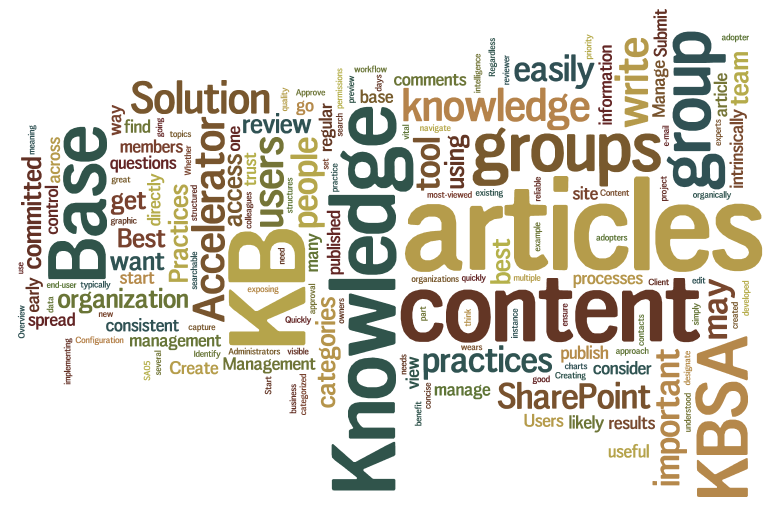| Knowledge Base Overview |
|---|
 Beyond what is visible to the end users in Knowledge Base, your KB administrator may want to control who has access to write the articles, review articles and publish them. These are the processes and business intelligence that go beyond the tool and are important considerations to think through before exposing a tool across the enterprise.
Beyond what is visible to the end users in Knowledge Base, your KB administrator may want to control who has access to write the articles, review articles and publish them. These are the processes and business intelligence that go beyond the tool and are important considerations to think through before exposing a tool across the enterprise.
Start small. The best way to get good collaboration practices going so that a group is thinking of topics they can write about in Knowledge Base is to start with a group that has cohesion, a reason to work together, and where all members are committed to the group and the quality of its results. For example, you may have an internal SharePoint Users Group where members are committed to sharing knowledge about SharePoint. Knowledge Base is a great tool for this type of group. It could be a project team, for instance, or perhaps a management group. What is important, is to start with groups that are intrinsically motivated to capture and share their knowledge, rather than groups that only exist in the organizational charts but which do not function as groups in practice.
Why is this important? Because Knowledge Base is the kind of tool that can easily spread organically on the grassroots level in an organization. If there is an early adopter group using Knowledge Base in a productive way, it is likely that their best practices will be spread to other colleagues – simply because people in organizations these days typically belong to several groups and social structures.
In a committed group of early adopters, it is likely that best practices will be developed, and those practices may be useful also to other groups within the organization.
The KB Admin site allows:
- Knowledge Base administrators to view data about articles and authors
- Create new articles
- Manage existing articles
- Approve and manage article comments
- Answer end-user questions
- Manage images
- Create and manage Knowledge Base article categories
The KB Client site lets users:
- Submit questions to Knowledge Base Administrators
- Quickly view recently added articles or most popular articles
- Use a tree to navigate KB content by category
- Search for and access articles directly from the search results
- Submit ratings and comments on published articles using a 5-star interactive graphic
- Display a tag cloud to enable users to quickly access the most-viewed articles by keyword
- Export articles to PDF directly or e-mail articles to other users
Best Practices you may want to consider:
- Identify an owner for your knowledge base. Whether this person is dedicated to the KB or wears many hats, you need one or two people on your team who are responsible for the KB content. The KB owners are the contacts for the team and can ensure that content is created and is consistent.
- If you don’t designate people to write content for your KB, then chances are no one will write content for your KB. Creating KB content has to be a priority, and part of the regular responsibilities for specific people or a group.
- Regardless of who is creating the content, it is vital that articles are clear, concise, and consistent.
- Content needs to be easily searchable and categorized, but you don’t want your categories to get out of control. If users can’t easily find answers in your KB, they might get frustrated and stop using the KB. Ensure you have categories that are intrinsically useful to multiple groups and easily understood to have a similar meaning across groups.
- Users trust that they are getting reliable information in a company’s knowledge base. But if they find too many errors or inconsistencies, they won’t trust the information and they won’t use the KB. So it’s important to have content reviewed by subject matter experts before it’s published.
- Establish regular review processes and consider implementing a SharePoint approval workflow so that all articles go through a reviewer. Using SharePoint permissions, you can set up groups for those who will write content, those who review content, approve it and publish.
Many of the Best Practices listed above and others your organization implements will help your company benefit from a structured approach to knowledge management.